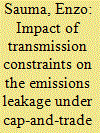|
|
|
Sort Order |
|
|
|
Items / Page
|
|
|
|
|
|
|
| Srl | Item |
| 1 |
ID:
174969


|
|
|
|
|
| Summary/Abstract |
The Irish Government has set very ambitious targets for the penetration of renewables into the Integrated Single Electricity Market (I-SEM), aiming for 40% electricity generation by 2020. This renewable share is expected to increase further in the I-SEM, British Electricity Trading and Transmission Arrangements (BETTA) and French electricity market by 2030. This research presents a case study testing the various levels of renewable energy integration in the three regions and assessed the economic impacts and benefits at elevated renewables penetration. To measure the economic and environmental sustainability, four indicators, i.e. annual wholesale system marginal prices (SMPs), total generation costs, total generation net revenues and emissions were selected. The results showed that the I-SEM 2030 wholesale electricity market pricing would range from €101.26/MWh to €50.77/MWh with the increase of renewable integration from 44% to 75%. In the BETTA and French market, the addition of the renewable generation contributes to reductions to SMPs by 51.10% and 51.61% at most, respectively. It was also found that these enhanced renewable targets for 2030 could lower consumers’ electricity bills and expand the total social welfare.
|
|
|
|
|
|
|
|
|
|
|
|
|
|
|
|
| 2 |
ID:
116923


|
|
|
|
|
| Publication |
2012.
|
| Summary/Abstract |
Several regional cap-and-trade (C&T) programs are considered or implemented in the United States to control greenhouse gas emissions from the power sector. One concern is the possibility of emissions leakage due to a lack of coherence in the geographic scope of the regional electricity market and the C&T program. Leakage in the context of regulating CO2 emissions is defined as the short-run displacement of CO2 emissions from the capped region to other uncapped regions due to the imposition of a regional C&T scheme. However, the presence of transmission congestion could interact with regulations in an unanticipated way to determining whether leakage would occur and its magnitude if happens. In this paper, we use a two-node network to study the conditions under which the CO2 leakage would happen in a radial network under a C&T program. These conditions are related to transmission capacity, merit order change, and relative production cost between capped and uncapped regions. Since CO2 leakage would likely occur in a radial network during the time when there is surplus transmission capacity, if regional CO2 policies could influence power grid management and operations decisions, then there might be space for a better multi-objective coordination.
|
|
|
|
|
|
|
|
|
|
|
|
|
|
|
|
| 3 |
ID:
150717


|
|
|
|
|
| Summary/Abstract |
The complementary features of low-carbon power sources are a central issue in designing energy transition policies. The French current electricity mix is characterised by a high share of nuclear power which equalled 76% of the total electric production in 2015. With the increase in intermittent renewable sources, nuclear flexibility is examined as part of the solution to balance electricity supply and demand. Our proposed methodology involves designing scenarios with nuclear and intermittent renewable penetration levels, and developing residual load duration curves in each case. The load modulation impact on the nuclear production cost is estimated.
|
|
|
|
|
|
|
|
|
|
|
|
|
|
|
|
| 4 |
ID:
176847


|
|
|
|
|
| Summary/Abstract |
This article analyzes the effects of implementing a two-stage carbon tax on a ten-year power expansion planning model. The timing effect of the tax is analyzed by studying the costs, capacity investments, economic dispatch, and CO emissions in fixed (flat) and two-stage tax schemes. Results show that, under the absence of political economy constraints, the most cost-effective solution is to have a low CO tax in the first stage and an optimal (higher) tax in the final stage. However, early actions can be justified depending on how relevant the policy maker considers the beneficial economic and not economic outcomes of a higher first-stage tax. Consequently, focusing on a final-period goal may not be the best way of facing the global warming problem, if emissions saved early have an important value when preventing the consequences of Climate Change.
|
|
|
|
|
|
|
|
|
|
|
|
|
|
|
|
| 5 |
ID:
163529


|
|
|
|
|
| Summary/Abstract |
The need to decarbonize the power sector through increased participation of renewable generation has originated an escalating necessity for transmission network investments that can be undertaken by a number of market participants, including planning authorities/system operators, network companies and project developers. The expansion of the power network, however, presents various environmental and social conflicts, in particular, with land uses that are valuable by society such as the presence of communities, national parks, protected forests, tourism zones, archaeological sites, etc. In this context of environmental and social awareness, we assess the benefits of two strategies that coordinate network investments among various participants and compare them against the current counterfactual approach, where no coordination is undertaken and thus renewable generation projects are connected to the main transmission system in an individual, project-by-project basis. Through various case studies based on the main Chilean transmission system, we show that the lack of coordination in network investments may present severe impacts in terms of the socio-environmental externalities of transmission network expansions. Furthermore, we demonstrate that attempting to reduce externalities of new network investments without proper coordination of new developments may significantly limit the success of a land use policy associated with network developments.
|
|
|
|
|
|
|
|
|
|
|
|
|
|
|
|
|
|
|
|
|